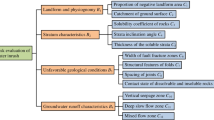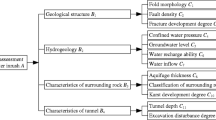Abstract
Water inrush makes time extended, instruments destructed, and casualty increased, which is the biggest threat for safe construction of tunnels in karst areas. A software system for risk assessment of water inrush was established with considering eight risk factors, including groundwater level, unfavorable geology, formation lithology, topography, strata inclination, excavation, advanced geological prediction, and monitoring. In the present software system, fuzzy mathematics and Analytical Hierarchy Process (AHP) were used to quantitatively describe the risk levels for each factor. The influence degree of each factor to water inrush was assigned an objective weight and a subjective weight, and the proportion of the two weights in the risk assessment was defined as weight distribution. The objective weights of the risk factors were obtained from more than 100 water inrush instances in karst tunnels, whereas the weight distribution was totally derived from expert field assessment and subjective weights were determined by using AHP in the risk assessment. Two case studies of karst tunnels were applied to check the reliability of the proposed software system, and the comparisons between the software assessment and practical excavation yield good consistency. Therefore, the software system can appropriately be used in practice to forecast water inrush in karst tunnels.












Similar content being viewed by others
References
Alan NB (2010) Tunnel safety, risk assessment and decision-making. Tunn Undergr Space Technol 25(1):91–94
Bukowski P (2011) Water hazard assessment in active shafts in Upper Silesian Coal Basin mines. Mine Water Environ 30(4):302–311
Canto-Perello J, Curiel-Esparza J, Calvo V (2013) Criticality and threat analysis on utility tunnels for planning security policies of utilities in urban underground space. Expert Syst Appl 40(11):4707–4714
Chen L, Huang HW (2006) The practice of risk management in Shangzhong road tunnel engineering. Chinese Journal of Underground Space and Engineering 2(1):65–69+73
Curiel-Esparza J, Canto-Perello J (2013) Selecting utilities placement techniques in urban underground engineering. Archives of Civil and Mechanical Engineering 13(2):276–285
Fouladgar MM, Yazdani-Chamzini A, Zavadskas EK (2012) Risk evaluation of tunneling projects. Arch Civ Mech Eng 12(1):1–12
Ge YH (2010) Study on water inrush risk and early warning mechanism of karst tunnel[Ph. D. Thesis]. Shandong University, Jinan
Gu YL, Li XH, Zhao Y, Ren S (2005) Analysis of forming reason of mud breakout in Tong-Yu Tunnel. Rock Soil Mech 26(6):920–923
Henrik B, Terje A (2012) Treatment of uncertainty in risk assessments in the Rogfast road tunnel project. Saf Sci 55(6):34–44
Huang HW, Zhu L, Xie XY (2007) Risk assessment on engineering feasibility of key events in Shanghai metro line No. 11. Chinese Journal of Geotechnical Engineering 29(7):1103–1107
Hwang JH, Lu CC (2007) A semi-analytical method for analyzing the tunnel water inflow. Tunn Undergr Space Technol 22(1):39–46
Karwowski WA (1986) Applications of approximate reasoning in risk analysis. In: Waldmar and Anil Mital (ed) Applications of fuzzy set theory in human factors. Elsevier, NewYork, pp 227–243
Li SC, Xue YG, Zhang QS, Li SC, Li LP, Sun KG, Ge YH (2008) Key technology study on comprehensive prediction and early-warning of geological hazards during tunnel construction in high-risk karst areas. Chin J Rock Mech Eng 28(7):1297–1307
Li LC, Yang TH, Liang ZZ, Zhu WC, Tang CA (2011a) Numerical investigation of groundwater outbursts near faults in underground coal mines. Int J Coal Geol 85:276–288
Li LP, Li SC, Chen J, Li JL, Xu ZH, Shi SS (2011b) Construction license mechanism and its application based on karst water inrush risk evaluation. Chin J Rock Mech Eng 30(7):1345–1355
Li SC, Zhou ZQ, Li LP, Xu ZH, Zhang QQ, Shi SS (2013) Risk assessment of water inrush in karst tunnels based on attribute synthetic evaluation system. Tunn Undergr Space Technol 38:50–58
Matthias S, Niels PH, Arild R, Harald B (2012) Risk assessment of road tunnels using Bayesian networks. Procedia - Social and Behavioral Sciences 48:2697–2706
Olga Š, Jirˇí Š, Daniel S (2013a) Probabilistic assessment of tunnel construction performance based on data. Tunn Undergr Space Technol 37(8):62–78
Olga Š, Eva N, Michal Š, Jirˇí Š (2013b) Probabilistic models for tunnel construction risk assessment. Adv Eng Softw 62–63(8–9):72–84
Ondrˇej N, Samuel P, Lukáš F (2011) Probabilistic risk assessment of highway tunnels. Tunn Undergr Space Technol 26(1):71–82
Saaty TL (1979) Applications of analytical hierarchies. Math Comput Simuin 21(1):1–20
Saaty TL (1990) How to make a decision: the analytic hierarchy process. Eur J of Oper Res 48(1):9–26
Xu ZH, Li SC, Li LP, Chen J, Shi SS (2011) Construction permit mechanism of karst tunnels based on dynamic assessment and management of risk. Chinese Journal of Geotechnical Engineering 33(11):1714–1725
Yan YR, Huang HW, Hu QF, Chen Y (2007) Risk assessment on drill and blasting method of Dalian Bay Subsea Tunnel. Chin J Rock Mech Eng 26(Supp.2):3616–3624
You JX, Tan X, Du XM (2006) The subway engineering integrated management system based on risk management. Chinese Journal of Underground Space and Engineering 2(1):28–31
Zhang QS, Li SC, Han HW, Ge YH, Liu RT, Zhang X (2009) Study on risk evaluation and water inrush disaster preventing technology during construction of karst tunnels. Journal of Shandong University(Engineering Science) 39(3):106–110
Zhou JW (2011) Coping with mud/water bursting in tunnel construction: case study on Baiyun Tunnel. Tunnel Construction 31(4):504–509
Zhou ZQ, Li SC, Li LP, Shi SS, Song SG, Wang K (2013) Attribute recognition model of fatalness assessment of water inrush in karst tunnels and its application. Rock Soil Mech 34(3):818–826
Acknowledgments
This study was supported by National Basic Research Program of China (2013CB036000), the State Key Program of National Natural Science of China (no. 51139004), Foundation of Shandong University (no. 2012TS064), Key Laboratory of Coal Resources Exploration and Comprehensive Utilization, Ministry of Land and Resources (KF2013-5), and Key Laboratory of Ocean Engineering (Ocean University of China), Shandong Province (201362047). The authors would be grateful to the reviewers for their valuable comments and suggestions that can help improve the quality of the paper.
Author information
Authors and Affiliations
Corresponding author
Rights and permissions
About this article
Cite this article
Li, L., Lei, T., Li, S. et al. Risk assessment of water inrush in karst tunnels and software development. Arab J Geosci 8, 1843–1854 (2015). https://doi.org/10.1007/s12517-014-1365-3
Received:
Accepted:
Published:
Issue Date:
DOI: https://doi.org/10.1007/s12517-014-1365-3




